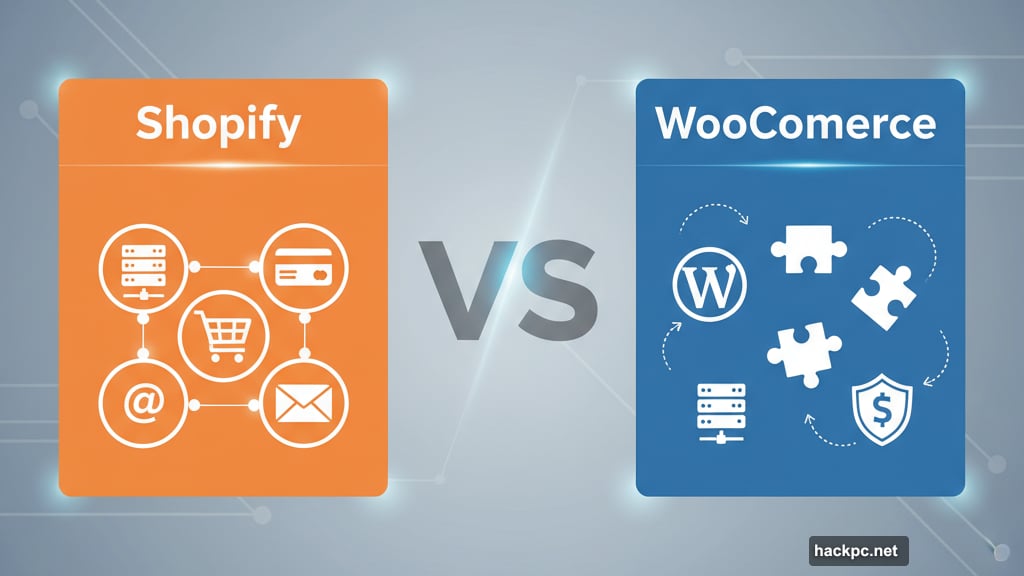
Building an online store sounds simple until you’re drowning in options. Two platforms dominate the e-commerce space: Shopify and WooCommerce. Both promise code-free store creation. But the experience couldn’t be more different.
I spent weeks testing these platforms to understand what separates them. One bundles everything into a clean package. The other gives you control but demands more effort. Let’s break down which suits your business.
Shopify Handles Everything. WooCommerce Requires Assembly
Shopify operates like an all-inclusive resort. You pay one fee and get hosting, design tools, payment processing, and marketing features bundled together. Everything lives in one dashboard. Plus, you don’t need to manage technical updates or security patches.
WooCommerce takes a different approach. It’s a free plugin that runs on WordPress websites. However, you need to purchase web hosting separately, install WordPress yourself, and connect various plugins for features like email marketing. Think of it as buying ingredients rather than ordering takeout.
This fundamental difference shapes everything else about these platforms.
Setting Up: Simple vs. Flexible
Shopify’s onboarding feels backwards at first. The platform pushes you to create products before choosing a theme or building core pages like About Us. That said, once you understand the navigation, most tasks become straightforward. Everything you need is built-in, with no plugins to install or update.
WooCommerce offers more intuitive menus but demands significantly more setup work. First, you select a web host and install WordPress. Then you add the WooCommerce plugin, configure payment options, and hunt down extensions for marketing tools. Each plugin brings its own settings to manage and regular updates to track.
The learning curve is steeper with WooCommerce. But current WordPress users will adapt quickly. Moreover, managed WooCommerce hosting from companies like SiteGround or Nexcess can automate updates and recommend essential plugins during setup.

Cost Reality: Budget Matters More Than You Think
Shopify starts at $29 monthly. That includes unlimited storage, bandwidth, and advanced inventory management. WooCommerce itself is free. Plus, WordPress hosting typically starts around $3 monthly with companies like SiteGround or Hostinger.
That price gap matters enormously for small stores. Selling low-cost items or digital products? Those $29 monthly Shopify fees can crush your margins. However, Shopify’s shipping discounts for services like UPS and DHL can offset costs if you’re shipping many physical products.
WooCommerce shines for tiny operations on shoestring budgets. Yet Shopify makes more sense for medium to large stores that need advanced features like automated inventory restocking and point-of-sale systems for in-person sales.
Marketing Tools: Built-In vs. Build-It-Yourself
Shopify bundles abandoned cart recovery, email marketing, discount codes, gift cards, and automated workflows into every plan. These tools work immediately without additional configuration. Furthermore, the email marketing system doesn’t charge extra until you exceed a certain subscriber count.
WooCommerce includes basic coupon codes. That’s it. You’ll need separate plugins for abandoned cart recovery, email marketing, and advanced promotions. Many email marketing tools are free initially but start charging when you pass 500 subscribers.
This creates another cost consideration. Free plugins can keep your total WooCommerce expenses below Shopify’s monthly fee. But you’ll invest significant time researching, installing, and configuring these tools.
Inventory Management: Automation vs. Manual Control

Shopify excels at inventory tracking for physical products. The platform offers automated reorder points and low-stock warnings. So when inventory drops below your threshold, Shopify can alert you or even trigger automatic reorders with suppliers.
WooCommerce provides basic inventory tracking that works fine for small catalogs. Yet everything operates manually. You track stock levels, set alerts yourself, and manage reordering without automation. Extensions can add advanced features, but you’ll need to find and configure them.
For stores with 10-20 products, WooCommerce’s manual approach is manageable. For catalogs with hundreds of SKUs, Shopify’s automation becomes invaluable.
Security: Shopify Protects by Default; WooCommerce Depends on Your Host
Shopify includes SSL certification, firewall protection, anti-DDoS defense, two-factor authentication, and 24/7 human security monitoring. That’s more than most web hosts provide. Additionally, Shopify’s team actively hunts for vulnerabilities across its platform.
WooCommerce security entirely depends on your hosting provider. Most hosts offer SSL certificates and firewall protection as baseline features. Companies like SiteGround and Liquid Web match Shopify’s security with anti-DDoS protection and proprietary security plugins. But budget hosts might skimp on advanced protections.
Research your host carefully. Security isn’t optional for e-commerce stores handling customer payment information.
Performance: Speed Matters for Sales
Shopify delivered 100% uptime and an average 1.71-second page load time during testing. That’s exceptional. Fast loading speeds directly impact sales, as 32% of visitors abandon sites that take longer than three seconds to load.
WordPress hosting speeds vary dramatically by provider. Hostinger achieved 2.34-second average load times. Liquid Web hit 2.37 seconds. SiteGround came in at 2.81 seconds. These speeds are acceptable but don’t match Shopify’s performance.

However, numerous WordPress plugins can boost site speed. So you might achieve Shopify-level performance with the right optimization on a WooCommerce store. It just requires more effort.
Customer Support: Live Chat Only vs. Multiple Channels
Shopify offers 24/7 live chat with fast, knowledgeable representatives. The knowledge base is comprehensive. But you can’t call or email for support, which frustrates some users.
WooCommerce provides email support and community forums. Yet you’ll primarily rely on your web host’s support team for technical issues. That support quality varies wildly. SiteGround and Ionos offer live chat, phone, and email support with excellent response times. Hostinger only provides AI-powered live chat that makes reaching humans difficult.
Choose your WooCommerce host based partly on support quality. You’ll need that help more than you think.
The Real Decision: Time vs. Money
Shopify trades money for simplicity. You’ll spend more monthly but save countless hours on setup, maintenance, and troubleshooting. This makes sense for busy entrepreneurs or larger stores where advanced features justify the cost.
WooCommerce trades time for flexibility and savings. You’ll invest significant effort learning WordPress, configuring plugins, and maintaining your site. But you can build a powerful store for $10-20 monthly instead of Shopify’s $29 minimum. Plus, the customization options are virtually unlimited.
Small stores selling digital products or low-cost items should strongly consider WooCommerce. The savings add up quickly. Medium to large stores selling physical products will likely benefit from Shopify’s automation, shipping discounts, and built-in tools.
Neither platform is objectively better. They serve different needs. Calculate your expected monthly costs, consider your available time, and choose accordingly.



Comments (0)